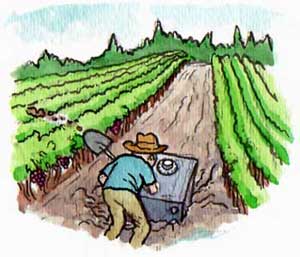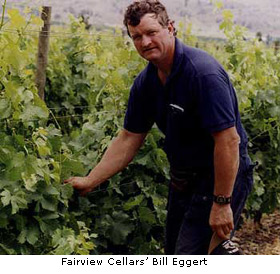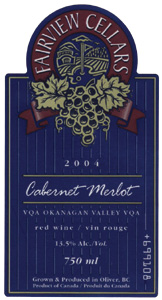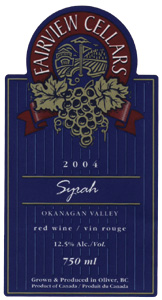

If you want vineyard tending secrets from Bill Eggert you're going to have to dig deep--and even then you might not find them.
Digging for Vineyard Secrets at Fairview Cellars
“A lot of winemakers will keep their blending close to their vests. For me, it goes back to my philosophy. I am not a winemaker;, I am a grape grower. My wine is made in the vineyard and it is the vineyard secrets I keep to myself, not the winemaking secrets.”
~Bill Eggert, owner, Fairview Cellars
by
John Schreiner
January 4, 2007
John Schreiner (JS): Why did you choose to establish on the Golden Mile? There were opportunities throughout the entire valley at the time.
Bill Eggert (BE): The main reason was financial. This property had no water on it. As a result, I was able to pick it up at base land price, without water, which was significant for me. I looked at the other side, Black Sage Road, but I really didn’t want to farm sand. I had farmed pure sand at Coverts and it is much less forgiving than the heavier soils we have here. This property has the perfect exposure for sunlight. It is on a knoll, so there is no frost. That was important. I saw the water problem as being fixable. It took me four years to get the water supply to the point where I felt confident enough to plant grapes.
JS: How did you solve the water problem?
BE: I get my water from Reed Creek [which comes off a nearby mountain]. There was a line to the property but it was only running about two gallons a minute. I had to rebuild an intake, replace almost a kilometre of line, and then properly put it underground. That allowed me to get it up to 20 gallons a minutes. For most of the year, I get 20 gallons a minute. In some years, it will still dry out later in the year. It depends on the year. In drought years, it got down to five gallons a minute but it was enough.
JS: What are the advantages of this site?
BE: I actually have three different soil types on this property.
JS: On six acres?
BE: Yes. I have a sandy gravel strip through the middle, then sand at the south end, and more of the heavier soil, with a higher clay content, at the north end. So I can get the complexity of different soil types from this little six acres. Different yields on those different portions. They are each too small to keep separate lots of wine. It is not as though it were a five acre block of one type of soil. It’s actually three different soil types in one row.
JS: What are the advantages to the lay of this land?
 BE: The way I explain it is: when does a person do his best work? In the morning, when the sun is shining but it is cool. It is the same with grapes. By the middle of the afternoon, it is so smoking hot that the grapes have all shut down. They won’t start up again for 12 or 15 hours. So after three o’clock, when it is over 35°C, the grapes aren’t working anyways. I am not that concerned about losing a little bit of sunshine at the end of the day. I would much prefer to have that sunshine early in the day, when the vines are morning-fresh and ready to go. That is one of the main reasons that I actually picked the west side of the valley.
BE: The way I explain it is: when does a person do his best work? In the morning, when the sun is shining but it is cool. It is the same with grapes. By the middle of the afternoon, it is so smoking hot that the grapes have all shut down. They won’t start up again for 12 or 15 hours. So after three o’clock, when it is over 35°C, the grapes aren’t working anyways. I am not that concerned about losing a little bit of sunshine at the end of the day. I would much prefer to have that sunshine early in the day, when the vines are morning-fresh and ready to go. That is one of the main reasons that I actually picked the west side of the valley.
JS: Were you taking a risk when you planted here?
BE: I only planted an acre and a half to begin with. I waited until I got my first crop before I planted any more. Christmas in 1995, which was when I had my first crop and I had enough for a barrel, is when I ordered Cabernet Franc. And then I planned to have more Cabernet Sauvignon later on.
Because of the water problems, I could not plant it all at once. It takes more water when you are planting.
JS: What did you plant to begin with?
A. I planted an acre of Cabernet Sauvignon and a half an acre of Merlot. I had a little bit of Cabernet Franc mixed in with the Cabernet Sauvignon. I got caught with the hot water treatment and I lost 25 percent of my vines in the first planting. [At the time, Canadian authorities, finding viruses on some vines coming from France, insisted on brutal treatment of them, including dipping them in hot water.] I replaced them in 1994 with Cabernet Franc because I couldn’t get any more Cabernet Sauvignon. But what it did was, it gave me Cabernet Franc right away.
JS: What is the current composition of the vineyard?
BE: It is about three acres of Cabernet Sauvignon and an acre and a half each of Merlot and Cabernet Franc. An acre and a third of Cabernet Franc, and about 1.6 acres of Merlot. And I planted one row of Petit Verdot this spring [2006]. It will be specifically for my Meritage.
JS: I believe you have Syrah as well?
BE: I have one row of Syrah … and my little plot in front of the tasting room. I took the Vidal out. I had planted the Vidal to do icewine with it, but after making several vintages of icewine with Lanny Swanky [owner of Willow Hill Vineyard], that was enough of that for me. So I pulled them out and planted Syrah.
JS: Is there room for more vines?
BE: I’ll probably plant a little more Petit Verdot and a little bit of Malbec, but a very small quantity. Altogether, I might be able to get one barrel of the two combined.
JS: Why did you decide this was a strong Cabernet Sauvignon site?
BE: The heat units are almost identical to Bordeaux, within a plus or minus five percent.
JS: What are the heat units here?
BE: The number 2,450 sticks in my head.
JS: Yet, you are not as hot here as on Black Sage Road.
BE: I suppose not in the afternoon, but I am warmer in the morning. You get to a certain point where, unless you are growing Shiraz or Sangiovese, the vines shut down anyway in that heat. Especially Cabernet Franc. It shuts right down.
JS: Many growers in the Okanagan planted Cabernet Franc because it is supposed to ripen earlier than Cabernet Sauvignon. Because the variety shuts down during heat spikes, it actually ripens later than Cabernet Sauvignon. How do you get your Cabernet Franc tasting ripe?
BE: One of the reasons that our Francs are so unique and tasty is that we let them ripen. It is agonizing, getting your kids dressed up for Halloween and thinking about harvesting the next day. That starts to get agonizing.
JS: You let them hang that long?
Bill Eggert (BE): The main reason was financial. This property had no water on it. As a result, I was able to pick it up at base land price, without water, which was significant for me. I looked at the other side, Black Sage Road, but I really didn’t want to farm sand. I had farmed pure sand at Coverts and it is much less forgiving than the heavier soils we have here. This property has the perfect exposure for sunlight. It is on a knoll, so there is no frost. That was important. I saw the water problem as being fixable. It took me four years to get the water supply to the point where I felt confident enough to plant grapes.

JS: How did you solve the water problem?
BE: I get my water from Reed Creek [which comes off a nearby mountain]. There was a line to the property but it was only running about two gallons a minute. I had to rebuild an intake, replace almost a kilometre of line, and then properly put it underground. That allowed me to get it up to 20 gallons a minutes. For most of the year, I get 20 gallons a minute. In some years, it will still dry out later in the year. It depends on the year. In drought years, it got down to five gallons a minute but it was enough.
JS: What are the advantages of this site?
BE: I actually have three different soil types on this property.
JS: On six acres?
BE: Yes. I have a sandy gravel strip through the middle, then sand at the south end, and more of the heavier soil, with a higher clay content, at the north end. So I can get the complexity of different soil types from this little six acres. Different yields on those different portions. They are each too small to keep separate lots of wine. It is not as though it were a five acre block of one type of soil. It’s actually three different soil types in one row.
JS: What are the advantages to the lay of this land?
 BE: The way I explain it is: when does a person do his best work? In the morning, when the sun is shining but it is cool. It is the same with grapes. By the middle of the afternoon, it is so smoking hot that the grapes have all shut down. They won’t start up again for 12 or 15 hours. So after three o’clock, when it is over 35°C, the grapes aren’t working anyways. I am not that concerned about losing a little bit of sunshine at the end of the day. I would much prefer to have that sunshine early in the day, when the vines are morning-fresh and ready to go. That is one of the main reasons that I actually picked the west side of the valley.
BE: The way I explain it is: when does a person do his best work? In the morning, when the sun is shining but it is cool. It is the same with grapes. By the middle of the afternoon, it is so smoking hot that the grapes have all shut down. They won’t start up again for 12 or 15 hours. So after three o’clock, when it is over 35°C, the grapes aren’t working anyways. I am not that concerned about losing a little bit of sunshine at the end of the day. I would much prefer to have that sunshine early in the day, when the vines are morning-fresh and ready to go. That is one of the main reasons that I actually picked the west side of the valley.
JS: Were you taking a risk when you planted here?
BE: I only planted an acre and a half to begin with. I waited until I got my first crop before I planted any more. Christmas in 1995, which was when I had my first crop and I had enough for a barrel, is when I ordered Cabernet Franc. And then I planned to have more Cabernet Sauvignon later on.
Because of the water problems, I could not plant it all at once. It takes more water when you are planting.
JS: What did you plant to begin with?
A. I planted an acre of Cabernet Sauvignon and a half an acre of Merlot. I had a little bit of Cabernet Franc mixed in with the Cabernet Sauvignon. I got caught with the hot water treatment and I lost 25 percent of my vines in the first planting. [At the time, Canadian authorities, finding viruses on some vines coming from France, insisted on brutal treatment of them, including dipping them in hot water.] I replaced them in 1994 with Cabernet Franc because I couldn’t get any more Cabernet Sauvignon. But what it did was, it gave me Cabernet Franc right away.
JS: What is the current composition of the vineyard?
BE: It is about three acres of Cabernet Sauvignon and an acre and a half each of Merlot and Cabernet Franc. An acre and a third of Cabernet Franc, and about 1.6 acres of Merlot. And I planted one row of Petit Verdot this spring [2006]. It will be specifically for my Meritage.
JS: I believe you have Syrah as well?
BE: I have one row of Syrah … and my little plot in front of the tasting room. I took the Vidal out. I had planted the Vidal to do icewine with it, but after making several vintages of icewine with Lanny Swanky [owner of Willow Hill Vineyard], that was enough of that for me. So I pulled them out and planted Syrah.
JS: Is there room for more vines?
BE: I’ll probably plant a little more Petit Verdot and a little bit of Malbec, but a very small quantity. Altogether, I might be able to get one barrel of the two combined.
JS: Why did you decide this was a strong Cabernet Sauvignon site?
BE: The heat units are almost identical to Bordeaux, within a plus or minus five percent.
JS: What are the heat units here?
BE: The number 2,450 sticks in my head.
JS: Yet, you are not as hot here as on Black Sage Road.
BE: I suppose not in the afternoon, but I am warmer in the morning. You get to a certain point where, unless you are growing Shiraz or Sangiovese, the vines shut down anyway in that heat. Especially Cabernet Franc. It shuts right down.
JS: Many growers in the Okanagan planted Cabernet Franc because it is supposed to ripen earlier than Cabernet Sauvignon. Because the variety shuts down during heat spikes, it actually ripens later than Cabernet Sauvignon. How do you get your Cabernet Franc tasting ripe?
BE: One of the reasons that our Francs are so unique and tasty is that we let them ripen. It is agonizing, getting your kids dressed up for Halloween and thinking about harvesting the next day. That starts to get agonizing.
JS: You let them hang that long?













